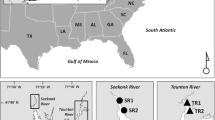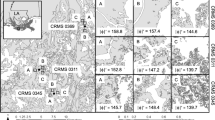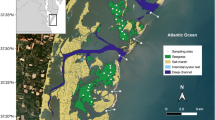Abstract
Much effort has been directed recently at restoring marshes, by the removal of the invasive common reed,Phragmites australis, yet it is not clear how fish and invertebrates have responded either to the invasion ofPhragmites or to marsh restoration. The blue crab,Callinectes sapidus, uses marsh habitats during much of its benthic life. We investigated the response of blue crabs toPhragmites invasion and restoration efforts by comparing crab abundance (catch per unit effort), mean size and size frequency distribution, sex ratio, and molting of crabs in three physically similar areas differing in marsh vegetation;Spartina-dominated,Phragmites-dominated, and a treated area (Phragmites removed and now dominated bySpartina) in one marsh in the upper portion of Delaware Bay. Field sampling occurred monthly (April to November) from 1999 to 2001 using replicate daytime otter trawls in large marsh creeks. Crabs were categorized by carapace width into recruits (<30 mm), juveniles (30–115 mm), and adults (>115 mm). Juveniles dominated the system, representing 69.4% of all crabs. Similar monthly increases in mean size and molting patterns during the growing season (May–August) occurred inSpartina (natural and treated sites) andPhragmites sites suggesting that, subtidal habitats, used for molting, in these areas do not differ. More juveniles in the feeding molt stage (i.e., intermolt) than in other molt stages and more recruits predominantly in the feeding molt stage than adults were inSpartina, suggesting differences in the marsh surfaces used as feeding habitats withSpartina being preferred. Sex ratios of each life history stage were skewed towards males, but this was related to the low salinity of Alloway Creek, rather than marsh surface vegetation. Our results suggest that marsh surface vegetation influences the way blue crabs use marsh surface habitats, thus restoration efforts focusing on changing vegetation type may have a positive influence on blue crabs.
Similar content being viewed by others
Literature Cited
Able, K. W. andS. M. Hagan. 2000. Effects of common reed (Phragmites australis) invasion on marsh surface macrofauna: Response of fishes and decapod crustaceans.Estuaries 23:633–646.
Bart, D. andJ. M. Hartman. 2000. Environmental determinants ofPhiragmites australis expansion in a New Jersey salt marsh: An experimental approachOikos 89:59–69.
Beck, M. W., K. L. Heck, K. W. Able, D. L. Childers, D. B. Eggleston, B. M. Gillanders, B. Halpern, C. G. Hays, K. Hoshino, T. J. Minello, R. J. Orth, P. F. Sheridan andM. R. Weinstein. 2001. The identification, conservation, and management of estuarine and marine nurseries for fish and invertebrates.Bioscience 51:633–641.
Benoit, L. K. andR. A. Askins. 1999. Impact of the spread ofPhragmites on the distribution of birds in Connecticut tidal marshes.Wetlands 19:194–208.
Boylan, J. M. andE. L. Wenner. 1993. Settlement of brachyuran megalopae in a South Carolina, USA, estuary.Marine Ecology Progress Series 97:237–246.
Cadman, L. R. andM. P. Weinstein. 1988. Effects of temperature and salinity on the growth of laboratory-reared juvenile blue crabsCallinectes sapidus Rathbun.Journal of Experimental Marine Biology and Ecology 121:193–208.
Cameron, J. N. 1989. Post-molt calcification in the blue crab,Callinectes sapidus: Timing and mechanism.Journal of Experimental Biology 143:285–304.
Chambers, R. M., L. A. Meyerson, andK. Saltonstall. 1999. Expansion ofPhragmites australis into tidal wetlands of North America.Aquatic Botany 64:261–273.
Cicchetti, G. andR. J. Diaz. 2000. Types of salt marsh edge and export of trophic energy from marshes to deeper habitats, p. 515–541.In M. Weinstein and D. Kreeger (eds.), Concepts and Controversies in Tidal Marsh Ecology. Kluwer Publishing, Dordrecht, The Netherlands.
Darnell, R. M. 1959. Studies of the life history of the blue crab (Callinectes sapidus Rathbun) in Louisiana waters.Transactions of the American Fisheries Society 88:294–304.
Dittel, A. I., C. E. Epifanio, S. M. Schwalm, M. S. Fantle, andM. L. Fogel. 2000. Carbon and nitrogen sources for juvenile blue crabsCallinectes sapidus in coastal wetlands.Marine Ecology Progress Series 194:103–112.
Drach, P. 1939. Mue et cycle d'intermue chez les crustaces decapodes.Annales de l'Institute Oceanographique 19:103–391.
Epifanio, C. E. 1995. Transport of blue crab (Callinectes sapidus) larvae in the waters off mid-Atlantic states.Bulletin of Marine Science 57:713–725.
Fell, P. E., S. P. Weissbach, D. A. Jones, M. A. Fallon, J. A. Zeppieri, E. K. Faison, K. A. Lennon, K. J. Newberry, andL. K. Reddington. 1998. Does invasion of oligohaline tidal marshes by reed grass,Phragmites australis (Cav) Trin ex Steud, affect the availability of prey resources for the mummichog,Fundulus heteroclitus L?Journal of Experimental Marine Biology and Ecology 222:59–77.
Fitz, H. C. andR. G. Wiegert. 1991. Utilization of the intertidal zone of a salt marsh by the blue crabCallinectes sapidus: Density, return frequency, and feeding habits.Marine Ecology Progress Series 76:249–260.
Freeman, J. A., G. Kilgus, D. Laurendeau andH. M. Perry. 1987. Postmolt and intermolt molt cycle stages ofCallinectes sapidus.Aquaculture 61:201–209.
Galatowitsch, S. M., N. O. Anderson andP. D. Ascher. 1999. Invasiveness in wetland plants in temperate North America.Wetlands 19:733–755.
Grothues, T. M. andK. W. Able. 2003. Response of juvenile fish assemblages in tidal salt marsh creeks treated forPhragmites removal.Estuaries 26:563–573.
Heck, Jr.,K. L. andL. D. Coen. 1995. Predation and the abundance of juvenile blue crabs: A comparison of selected east and Gulf coast (USA) studies.Bulletin of Marine Science 57:877–883.
Hines, A. H., R. N. Lipcius andA. M. Haddon. 1987. Population dynamics and habitat partitioning by size, sex, and molt stage of blue crabsCallinectes sapidus in a subestuary of central Chesapeake Bay.Marine Ecology Progress Series 36:55–64.
Kneib, R. T. 1982. The effects of predation by wading birds (Ardeidae) and blue crabs (Callinectes sapidus) on the population size structure of the common mummichog,Fundulus heteroclitus.Estuarine, Coastal and Shelf Science 14:159–165.
Kneib, R. T. 1997. The role of tidal marshes in the ecology of estuarine nekton, p. 163–220.In A. D. Ansell, R. N. Gibson, and M. Barnes (eds.), Oceanography and Marine Biology: An Annual Review. UCL Press, London, U.K.
Lenssen, J. P. M., F. B. J. Menting, W. H. Van der Putten, andC. Blom. 2000. Variation in species composition and species richness withinPhragmites australis dominated riparian zones.Plant Ecology 147:137–146.
Lipcius, R. N. andW. A. Van Engel. 1990. Blue crab population dynamics in Chesapeake Bay: Variation in abundance (York River, 1972–1988) and stock-recruit functions.Bulletin of Marine Science 46:180–194.
Malakoff, D. 1998. Restored wetlands flunk real-world test.Science 280:371–372.
McConaugha, J. R., D. F. Johnson, A. J. Provenzano, andR. C. Maris. 1983. Seasonal distribution of larvae ofCallinectes sapidus (Crustacea: Decapoda) in the waters adjacent to Chesapeake Bay.Journal of Crustacean Biology 3:582–591.
Miller, R. E., S. D. Sulkin andR. L. Lippson. 1975. Composition and seasonal abundance of the blue crab,Callinectes sapidus Rathbun, in the Chesapeake and Delaware Canal and adjacent waters.Chesapeake Science 16:27–31.
Millikin, M. R. andA. B. Williams. 1980. Synopsis of biological data on the blue crab,Callinectes sapidus Rathbun. National Oceanic and Atmospheric Association Technical Report N.M.F.S. 1. Report Number FAO Fisheries Synopsis 138. National Oceanic and Atmospheric Administration, Washington, D.C.
Minello, T. J. andJ. W. Webb, Jr. 1997. Use of natural and createdSpartina alterniflora salt marshes by fishery species and other aquatic fauna in Galveston Bay, Texas, USA.Marine Ecology Progress Series 151:165–179.
Orth, R. J., K. L. Heck, Jr., andR. J. Diaz. 1991. Littoral and intertidal systems in the Mid-Atlantic coast of the United States, p. 193–214.In A. C. Mathieson and P. H. Nienhuis (eds.), Ecosystems of the World 24: Intertidal and Littoral Ecosystems. Elsevier, Amsterdam, The Netherlands.
Orth, R. J. andJ. van Montfrans. 1990. Utilization of marsh and seagrass habitats by early stages ofCallinectes sapidus: A latitudinal perspective.Bulletin of Marine Science 46:126–144.
Otto, S., P. M. Groffman, S. E. G. Findlay andA. E. Arreola. 1999. Invasive plant species and microbial processes in a tidal freshwater marsh.Journal of Environmental Quality 28:1252–1257.
Peterson, G. W. andR. E. Turner 1994. The value of salt marsh edge vs interior as a habitat for fish and decapod crustaceans in Louisiana tidal marsh.Estuaries 17:235–262.
Rountree, R. A. andK. W. Able. 1993. Diel variation in decapod crustacean and fish assemblages in New Jersey polyhaline marsh creeks.Estuarine, Coastal and Shelf Science 37:181–201.
Rozas, L. P. andC. Hackney. 1984. Use of oligohaline marshes by fishes and macrofaunal crustaceans in North Carolina.Estuaries 7:213–224.
Rozas, L. P. andD. J. Reed. 1993. Nekton use of marsh-surface habitats in Louisiana (USA) deltaic salt marshes undergoing submergence.Marine Ecology Progress Series 96:147–157.
Ryer, C. H., J. Van Montfrans, andK. E. Moody. 1997. Cannibalism, refugia and the molting blue crab.Marine Ecology Progress Series 147:77–85.
Ryer, C. H., J. van Montfrans, andR. J. Orth. 1990. Utilization of a seagrass meadow and tidal marsh creek by blue crabsCallinectes sapidus. II. Spatial and temporal patterns of molting.Bulletin of Marine Science 46:95–104.
Schaffner, L. C. andR. J. Diaz. 1988. Distribution and abundance of overwintering blue crabs,Callinectes sapidus, in the lower Chesapeake Bay.Estuaries 11:68–72.
Seneca, E. D. andS. W. Broome. 1992. Restoring tidal marshes in North Carolina and France, p. 53–73.In G. W. Thayer (ed.), Restoring the Nation's Marine Environment. Maryland Sea Grant, College Park, Maryland.
Shay, J. M., P. M. J. de Geus, andM. R. M. Kapinga. 1999. Changes in shoreline vegetation over a 50-year period in the Delta Marsh, Manitoba in response to water levels.Wetlands 19:413–425.
Sogard, S. M. andK. W. Able. 1991. A comparison of eelgrass, sea lettuce macroalgae, and marsh creeks as habitats for epibenthic fishes and decapods.Estuarine, Coastal and Shelf Science 33:501–519.
Sokal, R. R. andF. J. Rohlf. 1981. Biometry. W. H. Freeman and Co., New York.
Steele, P. andT. M. Bert. 1994. Population ecology of the blue crab,Callinectes sapidus Rathbun, in a subtropical estuary: Population structure, aspects of reproduction, and habitat partitioning. Florida Marine Research Institute Publication. Report Number 51. Florida Marine Research Institute, St. Petersburg, Florida.
SYSTAT. 1992. SYSTAT: Statistics, SYSTAT, Inc., Evanston, Illinois.
Templer, P., S. Findlay, andC. Wigand. 1998. Sediment chemistry associated with native and non-native emergent macrophytes of a Hudson River marsh ecosystem.Wetlands 18:70–78.
Thayer, G. W. (ed.) 1992. Restoring the Nation's Marine Environment. Maryland Sea Grant, College Park, Maryland.
Thomas, J. L., R. J. Zimmerman andT. J. Minello. 1990. Abundance patterns of juvenile blue crabs (Callinectes sapidus) in nursery habitats of two Texas bays.Bulletin of Marine Science 46:115–125.
Van Engel, W. A. 1958. The blue crab and its fishery in Chesapeake Bay: Reproduction, early development, growth and migration.Commercial Fisheries Review 20:6–16.
Van Engel, W. A. 1990. Development of the reproductively functional form in the male blue crab,Callinectes sapidus.Bulletin of Marine Science 46:13–22.
Wainright, S. C., M. P. Weinstein, K. W. Able andC. A. Currin. 2000. Relative importance of benthic microalgae, phytoplankton and the detritus of smooth cordgrassSpartina alterniflora and the common reedPhragmites australis to brackish-marsh food webs.Marine Ecology-Progress Series 200: 77–91.
Weinstein, M. P. andJ. H. Balletto. 1999. Does the common reed,Phragmites australis, affect essential fish habitat?,Estuaries 22:793–802.
Weinstein, M. P., J. H. Balletto, J. M. Teal, andD. F. Ludwig. 1997. Success criteria and adaptive management for a largescale wetland restoration project.Wetlands Ecology and Management 4:111–127.
Welch, J. M., D. Rittschof, T. M. Bullock andR. B. Forward, Jr. 1997. Effects of chemical cues on settlement behavior of blue crabCallinectes sapidus postlarvae.Marine Ecology Progress Series 154:143–153.
Wilcox, D. A. andT. H. Whillans. 1999. Techniques for restoration of disturbed coastal wetlands of the Great Lakes.Wetlands 19:835–857.
Wilson, K. A., K. W. Able andK. L. Heck, Jr. 1990. Habitat use by juvenile blue crabs: A comparison among habitats in southern New Jersey.Bulletin of Marine Science 46:105–114.
Windham, L. andR. G. Lathrop. 1999. Effects ofPhragmites australis (common reed) invasion on aboveground biomass and soil properties in brackish tidal marsh of the Mullica River, New Jersey.Estuaries 22:927–935.
Zedler, J. B. 1992. Restoring cordgrass marshes in Southern California, p. 7–41.In G. W. Thayer (ed.) Restoring the Nation's Marine Environment. Maryland Sea Grant, College Park, Maryland.
Author information
Authors and Affiliations
Corresponding author
Rights and permissions
About this article
Cite this article
Jivoff, P.R., Able, K.W. Blue crab,Callinectes sapidus, response to the invasive common reed,Phragmites australis: Abundance, size, sex ratio, and molting frequency. Estuaries 26, 587–595 (2003). https://doi.org/10.1007/BF02823733
Received:
Revised:
Accepted:
Issue Date:
DOI: https://doi.org/10.1007/BF02823733




